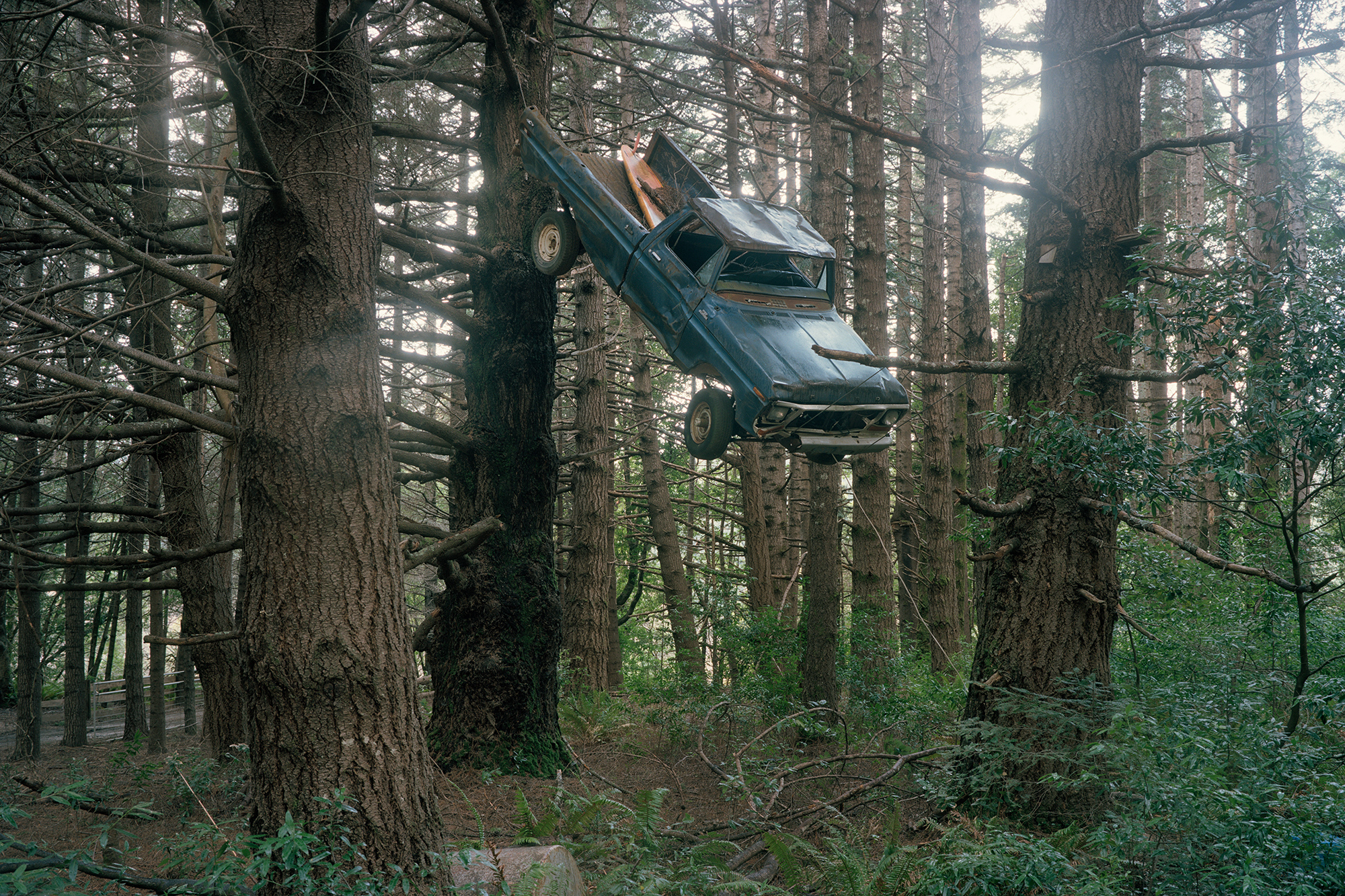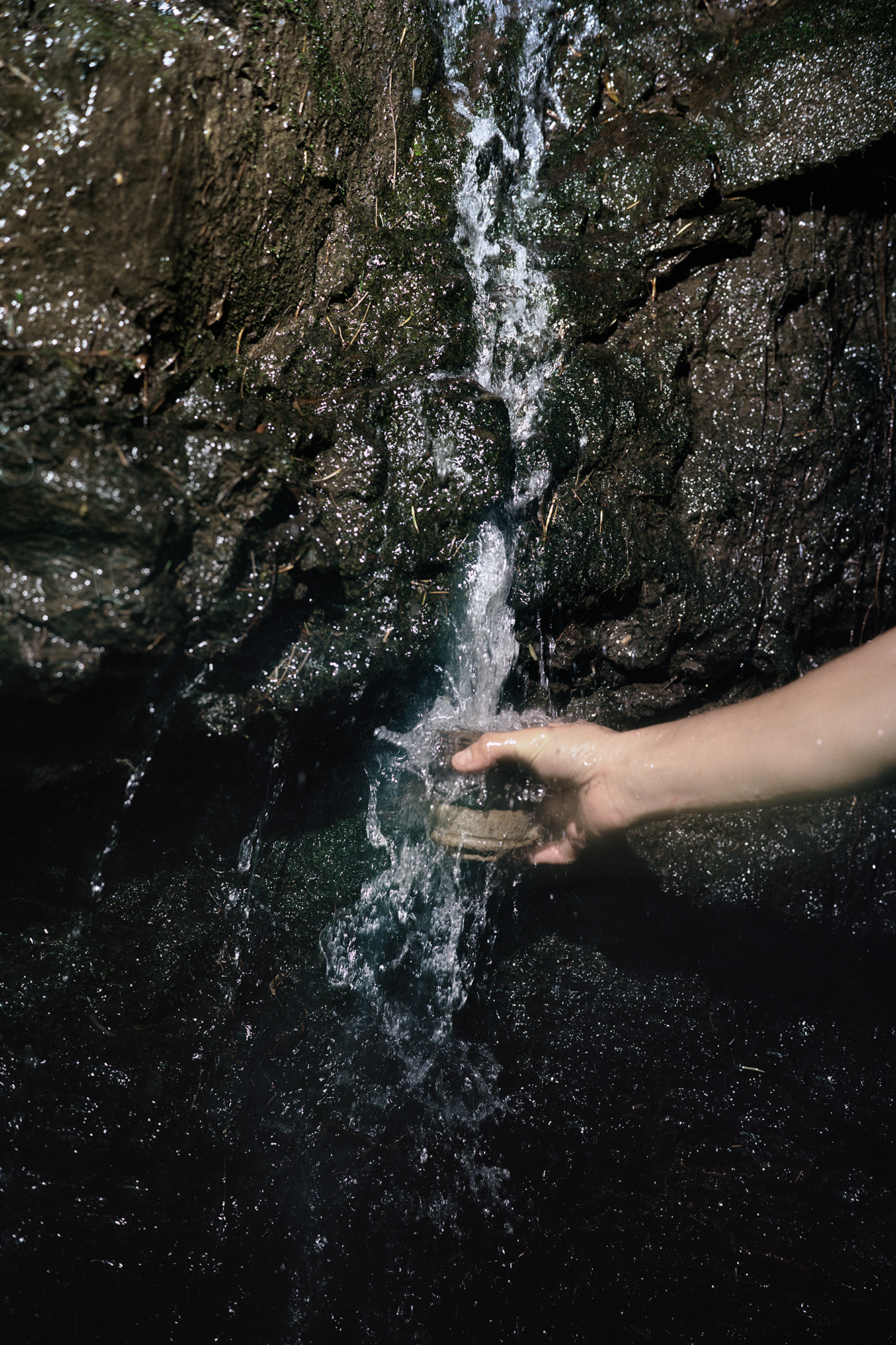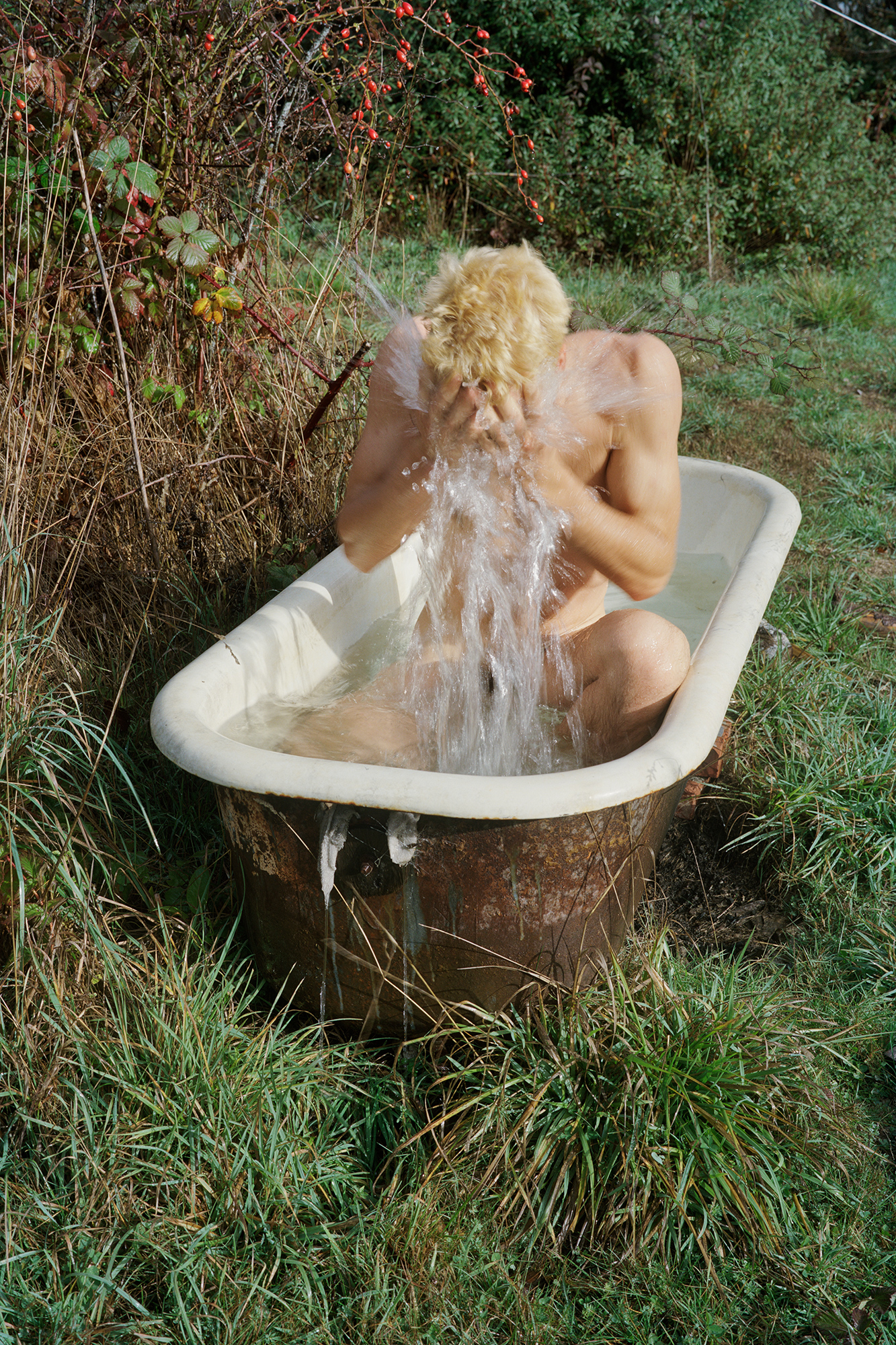
Eric Ruby & Aubrey Trinnaman
In conversation
⍱ ⍱ ⍱
AT: I’m curious what drew you to this place and how did your process of documenting it unfold?
ER: I first went with my friend Kenyon from San Francisco. He was always telling me about his roommate (who hadn't been around all summer) and how magical the place where she grew up was. At a certain point I doubted it and she existed because it all sounded so mythical, and then we finally planned a trip there. Immediately it was the California utopia I had always known that was out there, but I just didn't know where it was. Fitting that it's called the Lost Coast. It was the blend of ocean, river, people, light, my ideal photographic situation.
AT: The light and air in these photographs is so palpable. There is this image of an orchard with a ladder, and although I had seen this photo a few times, I was surprised at how much nostalgia I felt recently when viewing it for the fourth time. I very much felt that I was in that orchard. The light. Many of these photos embody for me some nostalgia and feelings of being young. There are so many signs of optimism or discovery... The ladder in the orchard, the bathtub with no plumbing nestled next to rose-hips, the outdoor bed in the grove of trees, clean and dressed. A feeling of like having your own fort in the bushes..a secret place to be curious and away from projected anythings. A safe and privileged place. A time freeze perhaps. What does 'time' feel like when you are there and how does photographing this place orient you in 'time'?
ER: The place in many aspects is an escape. For me, it was an escape from my city life. For the back-to-the-landers of the late ‘60s and ‘70s it was a return to a completely different type of lifestyle, a rejection of the previous generation. In both situations the escape can hold true -- a day feels like a week there, but in the best possible way. Any activities you do are staged in a beautiful place with calming energy. The hardest part is trying to capture that energy. Sometimes it feels disingenuous to myself to try and photograph it rather than just experience it. Which is why I tend to photograph and re-photograph things to try and gain that sense of time and space more cyclically, in a hope for something more cumulative.


AT: Yes. I wondered about this... I have noticed that about your work in general and in this body of work in particular ~ that revisitation of the same people and sites. The same man sits in the same chair, once with a beard and once clean shaven. The truck in the trees is photographed from the same point of view in what appears to be different seasons. Can you talk a bit more about what that sort of revisitation does for you?
ER: In some sense it's practicality. Dick (the guy in the chair) is a friend of mine, and he's just an interesting person to photograph and talk to, so when I go visit, it's a no brainer. In general, I don't like to pass up photographing something, because it will never be the same. Another person I had photographed there, Dottie-- I brought a print with me to give to her and she had died the night I arrived. It was a realization to me that it's important to take the opportunities that are given to you. With the truck in the tree (Dick's old truck), it's jokingly known as the local tourist attraction. There's infinite pictures of it and that's just something I want to participate in. Are any of the pictures of the truck any better than any others? Or is it just that the scene is so incredible that it's obligatory? Maybe it's my Grand Canyon type of picture. The revisitation is also a self competitiveness tendency I have to always try and make something slightly better. Even if you make a great picture of something, you can still make another.
AT: Does having your camera with you there help you feel more communion with the place or separateness? Can you talk to me a bit about how your photographic practice blends with your way of interacting in the world ?
ER: Separateness, without a doubt. I try to be as minimal as I can with my camera. I know people say they don't mind, but I just don't like being intrusive in general. My style of photographing is more like casually hanging out, and maybe take a quick picture, but also maybe not. I try not to be too forceful. I think in different situations obviously that can be different, but a lot of my "Art" is just from my normal life, sort of a blend of what I am interested in observing and interacting with, without too much of an agenda. At this point, my photographic practice and interacting with the world are one, perhaps not always healthy, but definitely keeps my eyes peeled.



AT: I have often felt very comfortable with how you blend it all. What is your relationship with light like in your photographing?
ER: I would say I'm definitely a careful observer of it, but very picky, and also not uniform in my idea of what's "good.” I think of light as being very experiential and emotive, and how that can translate from life to a photograph. Even in "terrible" high noon light, can you still make it work if it evokes that experience? The trouble is that usually I have to modify it to actually make it work in a photograph, which is the tricky part.
AT: Throughout your work and this project in particular, I feel a salient coexistence of possibility/vitality and nature/the rules of time. The first image I viewed in this work is a suspended old truck in a redwood forest that could either be seen as some old glory of a whip flying in its immortal exaltation or something very different: an eroded human relic fallen from space soon to crash like an asteroid head-on into the earth. The next image is a fleshy, brand-new-skinned infant laying in the middle of a rug looking directly at me with an unaffected gaze, fecund with possibility but somehow I feel as though they already know the course ahead. Can you talk a bit about how Mother Nature and Freewill present themselves to you in that place?
ER: It really is the place of my own ideal childhood, a sort of Huck Finn adventure, but for the most part with parents that are really on the same page because in some ways they are also having a second childhood. Of course, it's not for everyone, but when I was a suburban kid I had to be dragged inside, even in the winter, and that was in a place with scarce access, but children can make do. When people refer to a sort of ideal childhood experience, I think it really ends up being about exploration without obligation.
The irony of our culture is that we limit that period of time to being 12 and under. I think in the Lost Coast, and places akin to it, the aim is to break free of those societal norms and reimagine what life and happiness can be. Nature goes hand in hand with that because we ourselves are animals and benefit from connection to land and our larger environments. Trying to attain that symbiosis to me sounds idyllic, while still being able to practically participate in the world at large is something that's really only imaginable within the last 15-20 years of our species.


AT: You are a prolific self publisher. Do you think you will make a photo book of this work?
ER: I’m good at the publishing part, not so much the distribution....but maybe talking to someone else about putting it out!
AT: Can you tell me about how you chose the title?
ER: A friend, and one of the people in the pictures, is named Skye. He grew this pot strain that was un-smokable, gave everyone tremendous anxiety in the mind and body, we named it Skies The Limit. Seemed fitting as a metaphor.
AT: We have talked recently about the inability to do a place justice through
photographs. You mentioned earlier the frustration that can come with trying to capture the energy here. Is that specific to this project?
ER: It's an inherent problem with any representation, it's never the real thing, and always biased. Something that feels right to me could be the opposite to another person. It's definitely not distinct to this project, but some places are easier to grapple with than others. This just happens to be a difficult one to me.
AT: What has been inspiring you lately on the tail of this weird year?
ER: As most people I think are experiencing, trying to figure out what my values actually are, and how to go about achieving them. I've always had an interest in how things work and just diving right in, so thinking a lot of sustainable building practices, water usage, waste and reuse. Those are things that are inspiring to me. Also food-- like a lot of people this year I had a very large garden and did the most food processing I've ever done! I made umeboshi, hoshigaki, 15 different kinds of jams, pressed wine, apple juice-- really just trying to engage my tendencies to explore in whatever medium that may be!


AT: Why do you photograph? (ha. don’t hate me)
ER: In some ways I'm a nihilist, and individual lifetimes can be negligible in geological time, so it's something to do to pass the time that I enjoy. In other ways it's an excuse to explore, interact, engage with the world and other people in it. In a lot of ways you could probably do the same without a camera, but I think it's more off-putting to people to not have a reason.
AT: How many times do you think you've visited the truck in the trees? How many times do you think you have photographed the truck in the trees?//
ER: Hm, that would be very hard to guess. The story with the truck is that Dick put it up in the trees in his driveway(with a surfboard in the bed) and there is a motion sensor so if you are driving down his driveway the lights would flash and the horn would honk, just an elaborate joke. The battery died a long time ago, so it's really a relic of the joke that you can also see from the road. I try to photograph it at least once every time I go, but it's not always right. Sometimes I pass it 5 times a day walking to go swim in the river and it starts to fade in your consciousness, then all of the sudden the light changes and it's this miraculous beacon.

AT: I wanted to ask you something about the mythic in your work…but I can’t figure out how. I suppose that’s at the heart of much of this interview, whether or not one can tap into and tell the mythic.
ER: To me, mythic really means the organization of a story in an oral tradition. However plausible it may be, it’s about passing on the story and maybe adding some accoutrement. No matter how over the top it seems though, it stems from something experienced, interpreted, and retold. In regards to my work? I hope my ego isn’t so large as to call myself a myth maker; I’d like to think I'm more of a myth seeker.
____
Eric Ruby is an artist that uses photographs, textiles, and bookmaking to weave together stories that try to translate lived experience. He lives in Berkeley, California.
Aubrey Trinnaman is a multidisciplinary artist whos work examines the relationships between the biotic and abiotic and the space between pleasure and prescription.
Eric Ruby is an artist that uses photographs, textiles, and bookmaking to weave together stories that try to translate lived experience. He lives in Berkeley, California.
Aubrey Trinnaman is a multidisciplinary artist whos work examines the relationships between the biotic and abiotic and the space between pleasure and prescription.
